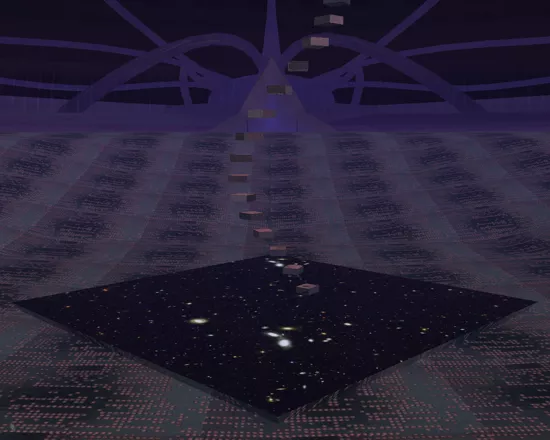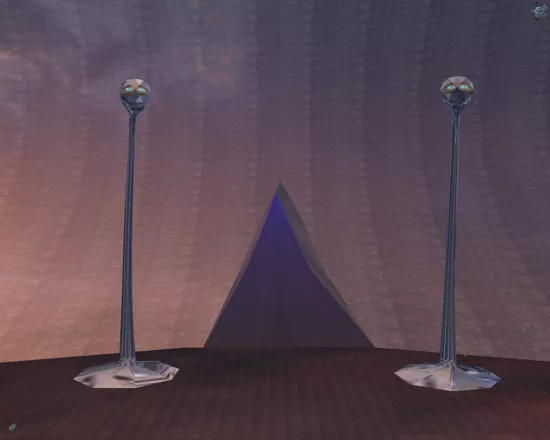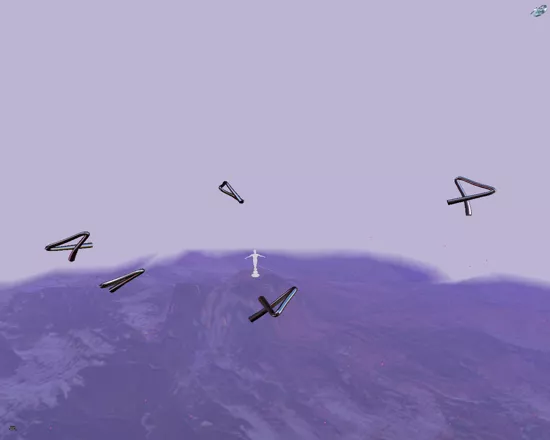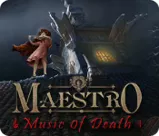MusicVR Episode 2: Maestro
Description official description
<>Maestro is the second installment of Mike Oldfield's MusicVR series. It is much like its predecessor, Tres Lunas, but bigger and grander in scope.
Maestro begins aboard a giant starship called the Virtual Voyager. Within this starship there are many rooms or compartments, connected by corridors and tubes. Some of these lead to portals that take you to areas entirely outside of the starship altogether.
Hiding somewhere in this world are four alien beings known as the Gravitars. Your goal is to find them and bring them back to the Gravitar Pen, somewhere within the Virtual Voyager. To accomplish this, however, you will need to learn the art of play. Like Tres Lunas, Maestro is open-ended in its design.
Groups +
Screenshots
Credits (Windows version)
5 People
| Created by | |
| 3D modeling, graphic and gameplay design | |
| Software Programming | |
| Graphic Artists |
Reviews
Players
Average score: 3.3 out of 5 (based on 2 ratings with 1 reviews)
The Good
Most of my commentary will take the form of comparisons between Maestro and its predecessor, Tres Lunas, because the conceptual design of Maestro is very much like that of Tres Lunas. It therefore shares many of the same strengths and weaknesses of the earlier game. For a more generalized commentary about the game design itself, read my review of Tres Lunas (also on MobyGames.com). Most of what I said about Tres Lunas is also true of Maestro.
That having been said, Maestro is bigger and more refined than its predecessor in almost every way. The game world is larger; more expansive. Where Tres Lunas centered on a desert area, Maestro's central location is a huge spaceship, full of corridors, tubes, shafts and many rooms or compartments to explore. As in Tres Lunas, some portals take the player to places seemingly outside of the central environment. In fact, at one point, you wind up literally on the outside of the spaceship. Compared to Tres Lunas, there's simply more to see and do. Tres Lunas could be played from start to completion in a matter of minutes once you knew where to search for the golden rings. Maestro requires at least a solid hour of play, even when you know exactly where to go and what to do.
The goals in Maestro are more varied and complex than in Tres Lunas. Tres Lunas had only one goal; to find and collect seven golden rings. In Maestro, you collect "medals" (which look like giant, metallic pinwheels) instead. You must find and collect 24 of these medals. There are actually many more than 24 medals to be found and, in a rather clever twist, you must be careful not to collect too many medals, too quickly. Some rooms can only be accessed with a specific number of medals, with a minimum number of medals (no less than...) or with a maximum number of medals (no more than...). If you're carrying more than that number, you're out of luck. If you have too many, there are ways to reduce the number of medals being carried but it's not as simple as just dropping them at will. At one point in the game, you are actually required to give away all of the medals collected to that point in order to advance in the game. I consider this a very nice touch, which discourages a "horde everything" approach and requires the player to think strategically. Certain things are best done in a certain order.
Aside from the medals, another new wrinkle is the Gravitars. There are four of them and they must be found and deposited in a Gravitar Pen in the game. The finding of the Gravitars is the game's ultimate object. The medals are really just a means toward this end. The player who brings the last of the four Gravitars to the Pen becomes The Maestro, and is given access to a special Maestro Area. That player also has the option of inviting any of his/her on-line friends to the Maestro Area as well. In an on-line game, where multiple players work together to find all the Gravitars, this gives the player who retrieves the last Gravitar a way of sharing the reward with his/her comrades.
While searching for medals and Gravitars, you will encounter various games and puzzles that must be solved or completed. Some involve mazes which must be navigated, and/or objects (other than Gravitars or medals) which must be found or collected. Overall, the puzzles and challenges are more interesting and more fun than those presented in Tres Lunas.
The Bad
I'm inclined to be a little more critical of Maestro than I was of Tres Lunas because Tres Lunas had the advantage of being completely new and unique. Having played and completed Tres Lunas, my very first impression after spending my first hour with Maestro was one of "More of the same".
"Well, this is all very nice," I thought to myself, "but it's basically like Tres Lunas. It's been done."
The visuals are not significantly improved over those seen in Tres Lunas; there's just more of them. This is not entirely bad, as Tres Lunas was, itself, a fairly attractive bit of eye-candy.
The sound or, more accurately, the music, is another matter. As in Tres Lunas, most of the sound consists of snippits of Oldfield's music. The difference is that, where Tres Lunas consisted entirely of new and original music (in fact, it was released hand-in-hand with an entire music CD by the same name), much of the music in Maestro consists of excerpts from Oldfield's Tubular Bells 2003; a music CD which was released several months before Maestro. Again, this isn't an entirely bad thing. Tubular Bells (and the 2003 remake) have always been among my favorite albums, and having the familiar music complemented by Oldfield's computer-generated images is an interesting and enjoyable experience. However, once again, I've already heard this music. Been there, done that. Although the game does feature some new and original music by Oldfield, especially when one reaches the Maestro Area, I'd have liked to see more emphasis on that and less on a rehash of previously-released material.
When playing alone, the game has an empty, solitary feel to it. Yes, there are all these wonderful environments to wander through, but there's nobody in them. There are entities; horses, dinosaurs, a scorpion, a crab, a blind man and, of course, the elusive Gravitars, to name but a few, but none of them really interact with the player in any meaningful way. They simply wander along their preprogrammed paths, seemingly oblivious to your presence. The feeling is something akin to being Alice, wandering through a deserted Wonderland or, rather, a Wonderland in which she is ignored by everyone and everything she encounters.
Playing on-line doesn't help the situation much. The main reason for this is, I suspect, because the game hasn't garnered nearly the kind of following that Oldfield had hoped it would. Most of the time, there are few, if any, active game servers out there. When there are, they are sparsely-populated; the most I've ever seen in one game at any time is six players. For someone who had apparently hoped to see Maestro become "The world's most magnificent chat room", Oldfield must be fairly disappointed so far.
The sparse on-line community coupled with the game's increased size doesn't help the matter either. After spending three hours in the aforementioned six-player on-line game, I never actually saw any of them. I saw their messages being exchanged, but I never encountered any of their avatars. This is doubtless because, with such a big game world to explore, and so few people in it, odds against any two of them winding up in the same area at the same time are fairly big.
Finally, Maestro has no Save Game feature, and it needs one badly! I'm sure that the omission of a way in which to save one's progress and resume later on was a conscious design decision on Oldfield's part. In Tres Lunas, this was forgivable because the game world was smaller and, as I said, the game could be finished quite quickly once one knew where to look for the rings. However, having to start from scratch every time one begins a game in Maestro and then having to traverse areas that one has seen many times before, and see and do things that one has seen and done many times before, soon becomes simply tedious and frustrating.
The Bottom Line
Maestro has the same basic appeal and the same basic weaknesses as does Tres Lunas. If you played and enjoyed Tres Lunas, and you're not looking for something radically different this time around, then you will likely enjoy Maestro. If you've tried neither game but are intrigued enough to try at least one of them, go with Maestro. In my opinion, it's the better of the two games. To guard against disappointment, though, download and try out the free demo before committing any cash to Maestro. It will give you a fairly good feel for what the game is all about.
Windows · by Halmanator (598) · 2004
Trivia
Inspiration
Mike Oldfield's primary goal in creating Maestro was not to make money (although in 2004 there was a £14.75 charge for the full downloadable version or £18.00 to receive a CD by mail). Oldfield's main goal, as with Tr3s Lunas, was to offer a different gaming experience from the mainstream. An enjoyable, non-violent, holistic experience.
Analytics
Upgrade to MobyPro to view research rankings!
Related Sites +
-
Maestro
The official website for Maestro. Here you can download either the full version or the demo, purchase the full version, see screenshots and learn more about the game.
Identifiers +
Contribute
Are you familiar with this game? Help document and preserve this entry in video game history! If your contribution is approved, you will earn points and be credited as a contributor.
Contributors to this Entry
Game added by Halmanator.
Additional contributors: Alaka.
Game added April 26, 2004. Last modified February 22, 2023.













